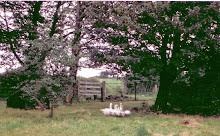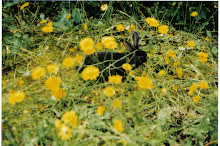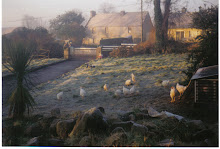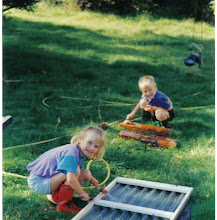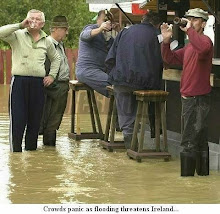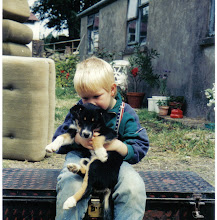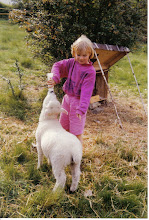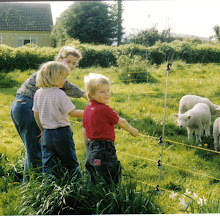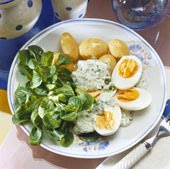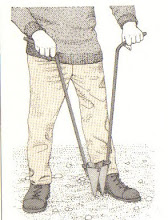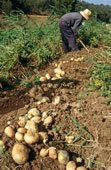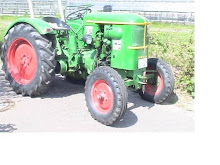In case you never heard about it: Milk is not really good for you--no reason for grown- ups to drink it. This excellent article claims you should stop. http://www.care2.com/greenliving/skip-milk-5-reasons-why.html:
"Chronic constipation, irritable bowel syndrome, arthritis, chronic sinusitis and allergies" are often "cleared up when they stopped eating dairy."
"In addition to being chemically altered into something that hard to digest and causes problems, today’s milk usually contains steroids, antibiotics, pesticides from treated grains, bacteria from infected animals, and genetically engineered growth hormones."
Sunday, May 23, 2010
Friday, May 21, 2010
Save Hay while the Sun Shineth
Warm summer weather and lots of sunshine are the prerequisite for haymaking, essential fodder for the animals in winter. These days, farms usually make silage, i.e. fermented, high-moisture fodder that can be fed to animals when they can no longer graze outside. Even today, making silage is THE bid social event of the agricultural year where the whole neighborhood gets involved and helps out, doing each farm in turn. The women folks’ job is to cook for the ‘silage men’. Silage is made either by placing cut green vegetation in a silo or by piling it in a large heap covered with plastic sheet, or by wrapping large bales in plastic film.
In our first summer, we had allocated only one field and our garden behind the house to making hay. We had opted to save hay the old-fashioned way by hand. Mac used an old scythe for cutting. No lawnmower gives the same result. The blade needed constant sharpening with a honing stone called ‘strickle’. After the grass was cut it had to be raked together in rows which had to be turned every other day. We were lucky, because showers stayed away—otherwise we would have ended up with a useless, indigestible mash. Hence the saying. Then the rows were raked into little heaps, dragon cocks, and then later when the hay had turned crisp and yellow, it was raked into triangle shaped forms called trams. Hay ropes secured the trams from the wind until they were brought into our hay barn. A family bonding experience surely − except when you are allergic to grass like 3 in our family were. One year later, we had a few more acres under hay, and we had them cut by a tractor and made into square bales. Mac loaded the square bales into the jeep and my task was to drive the jeep to the hay barn where a farmhand unloaded and stacked them up. After several trips my hay fever and asthma got the better of me. My nose was the running; I sneezed, accompanied by itching eyes and coughs. Mac’s advice was to take some medication against the unwanted symptoms. I went on strike instead. No more hay transporting in our family car for me. In the following years when he managed the full acreage himself, a contractor did all the work.
In our first summer, we had allocated only one field and our garden behind the house to making hay. We had opted to save hay the old-fashioned way by hand. Mac used an old scythe for cutting. No lawnmower gives the same result. The blade needed constant sharpening with a honing stone called ‘strickle’. After the grass was cut it had to be raked together in rows which had to be turned every other day. We were lucky, because showers stayed away—otherwise we would have ended up with a useless, indigestible mash. Hence the saying. Then the rows were raked into little heaps, dragon cocks, and then later when the hay had turned crisp and yellow, it was raked into triangle shaped forms called trams. Hay ropes secured the trams from the wind until they were brought into our hay barn. A family bonding experience surely − except when you are allergic to grass like 3 in our family were. One year later, we had a few more acres under hay, and we had them cut by a tractor and made into square bales. Mac loaded the square bales into the jeep and my task was to drive the jeep to the hay barn where a farmhand unloaded and stacked them up. After several trips my hay fever and asthma got the better of me. My nose was the running; I sneezed, accompanied by itching eyes and coughs. Mac’s advice was to take some medication against the unwanted symptoms. I went on strike instead. No more hay transporting in our family car for me. In the following years when he managed the full acreage himself, a contractor did all the work.
Thursday, May 13, 2010
A Killer Horse named Scarlett
Most little girls like ponies and get into horse-riding. Amy had had riding lessons in Germany before we emigrated and now wished for a pony of her own. The first we got for her was Sparky, but she suffered from laminitis, an inflammation of the hooves often caused by lack of exercise and overeating. She was soon returned and replaced by Rusty who stayed with us till the kids had outgrown a pony that size. To look after a pony entails a lot of responsibilities for a little girl: grooming,riding,feeding and mucking out, in the morning before school and last thing at night. Rusty was housed in one of the outbuildings next to the tack room. She would be prone to that disease as well if you let her feed all day and night in a field of fresh grass.
A keen horseman himself, Mac acquired a 3/4 thoroughbred to go hunting with,a good 15 hands in height, a filly of two years and just broken in. She was quite the primadonna under the horses and had a temperament.
I've always been afraid of horses and their sheer size. On the first day that Scarlett was out in the fields, she frightened the life out of me. It was in new surroundings and appropriately frisky.That was the day we decided to set Benny Bunny free down by the river(See previous blog).I carried him in a box and had both kids,7 and 4, tagging along on either side chatting away. Scarlett circled us for most of the way, coming dangerously close at times. The kids tugged at my arms, frightened, but I couldn't let go of that box. We increased our pace until we made it over the river. There, I reasoned, with out the encumbrance of the box I would be free-- to do what I wasn't sure though. When we stared climbing the hill back up, Scarlett came charging towards us, whinnying and circling us. Her hind legs were precariously close to the heads of my children. Hearts racing, we pressed on and back to the house. Mac appeared at the top of the hill, arms stemmed by his sides: "What's going on?" I shouted: "For God's sakes, grab your killer horse and lead it out of harm's way! It's attacking us!" He shook his head at my ignorance. " Don't you know you just have to shout to shoo them away? That scares them and tells them who is the boss." Hands cupped around his mouth, he yelled a piercing "boo" twice, and Scarlett cantered away, and we to the safety of the gate. After that I preferred to have a stable door between her and me. Both kids, however, overcame their fear and became horsey people, jumping and all.
A keen horseman himself, Mac acquired a 3/4 thoroughbred to go hunting with,a good 15 hands in height, a filly of two years and just broken in. She was quite the primadonna under the horses and had a temperament.
I've always been afraid of horses and their sheer size. On the first day that Scarlett was out in the fields, she frightened the life out of me. It was in new surroundings and appropriately frisky.That was the day we decided to set Benny Bunny free down by the river(See previous blog).I carried him in a box and had both kids,7 and 4, tagging along on either side chatting away. Scarlett circled us for most of the way, coming dangerously close at times. The kids tugged at my arms, frightened, but I couldn't let go of that box. We increased our pace until we made it over the river. There, I reasoned, with out the encumbrance of the box I would be free-- to do what I wasn't sure though. When we stared climbing the hill back up, Scarlett came charging towards us, whinnying and circling us. Her hind legs were precariously close to the heads of my children. Hearts racing, we pressed on and back to the house. Mac appeared at the top of the hill, arms stemmed by his sides: "What's going on?" I shouted: "For God's sakes, grab your killer horse and lead it out of harm's way! It's attacking us!" He shook his head at my ignorance. " Don't you know you just have to shout to shoo them away? That scares them and tells them who is the boss." Hands cupped around his mouth, he yelled a piercing "boo" twice, and Scarlett cantered away, and we to the safety of the gate. After that I preferred to have a stable door between her and me. Both kids, however, overcame their fear and became horsey people, jumping and all.
Subscribe to:
Posts (Atom)




























